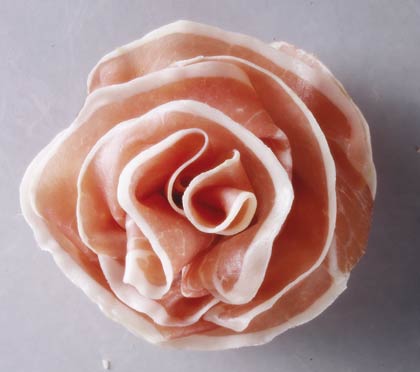There is a whole lot of cured pork in September’s issue of Food and Wine Magazine, but not in the form of bacon. Instead, bacon’s Italian cousins – prosciutto and pancetta – are prominently featured due to this particular issue’s focus on Italy.
Even though prosciutto and pancetta are forms of cured pork, they are quite different from their American bacon counterpart. Prosciutto is cut from the rear of the pig like ham. And it is usually eaten raw. The taste is also much sweeter and nuttier than American ham and bacon. It is eaten in very thin slices.
Pancetta is more like bacon in that it is cured pork belly. But pancetta is not smoked. It is also often eaten raw, although it is also used in sauces and other hot dishes.
Even though American bacon is a distant cousin of prosciutto and pancetta, cured pork in any form is lovely and worthy of a mention on this blog. So here’s a rundown on the various ways in which Italian cured pork is featured in this month’s issue of Food and Wine:
- B-Said, a café inside the DeMauro family chocolate factory in Rome, serves “savory dishes like lasagnetta with speck and asparagus.”
- Marco Bolasco, editor of the Gambero Rosso dining guides, talks about Italy’s top chefs. Anna Dente Ferracci of Osteria di San Cesario is serving traditional dishes like carbonara.
- Ristorante Babette in Rome serves their carbonara with strips of zucchini and carrot.
- One of the recipes featured from the Italian region of Emilia-Romagna (the premiere prosciutto producing region in Italy) was a salad of bitter greens with balsamic-glazed prosciutto. “Prosciutto and pancetta both require months to cure, but sometimes they’re eaten before they’ve fully aged. In Emilia-Romagna, cooks turn that partially cured meat into dishes like pancetta fresca alla griglia, in which the pork is grilled, then lacquered with balsamic vinegar.” They also featured a dish made with piadina (flat bread) with ricota, prosciutto and argula.
- In the test kitchen, Food and Wine cooks attempted to make the perfect tomato sauce. They also experimented with two variations on it – All’ Amatriciana sauce (with sauted pancetta, crushed red pepper and garlic) and Vodka Sauce (with sauted pancetta, crushed red pepper, garlic, vodka and heavy cream).
- In identifying the top 25 Italian wines under $20, the author mentions that “Italian reds tend to be higher in acidity than American wines, which means that they’re more difficult to drink on their own but terrific with food (for instance, some prosciutto and Parmigiano-Reggiano).”
- A two page advertisement promotes Prosciutto di Parma and Parmigiano Reggiano as “masterworks” that are “produced in the Emilia-Romagna region of Italy by skilled craftsmen, using methods that have been handed down through the centuries and ingredients that, by law, must be sourced locally.”
- Salvatore Denaro, chef-owner of the trattoria Il Bacco Felice in the Umbrian town of Foligno, prepares an antipasto platter by “carving slices of a boned and tied prosciutto from Naples. As he carves, he passes slices to whomever happens to be around. ‘Here, try this,’ he cries. ‘It’s an ancient technique; you don’t get this anymore. How sweet it is!'”
- “Italian cured meats – delicate prosciutto and darker, sweeter culatello – go perfectly with Italian wine.” The writer suggests trying prosciutto with Fiano wines from Campania and Garganega wines from Veneto.
Salute!

